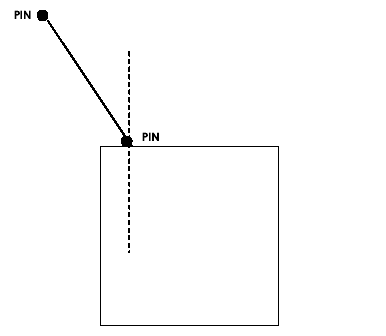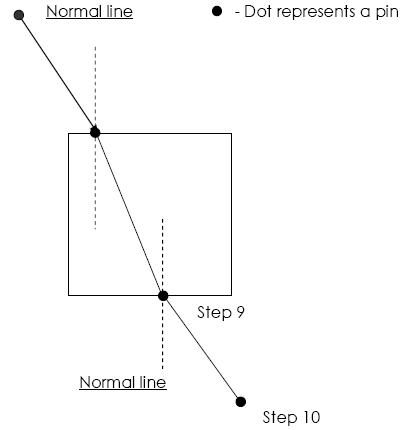Refraction of Light from Air to Glass
Purpose: To use Snell's Law to determine the index of
refraction (n) of a piece of glass and to use it to find the speed of light in
that glass.
Procedure: Check off
each procedure upon completion
1. _____ Place your glass in the middle of a piece of
loose leaf and sketch its outline with a pencil.
2. _____ Remove the glass and draw a normal line
about 1 cm from the end of the glass as illustrated

3. ____Draw an arrow 30 degrees from the normal. (** Put the zero degree
guideline of your protractor on
normal line**)
4. ____Put a piece of cardboard underneath your loose
leaf.
5. ____Place a pin at each end of the line you just
drew (see illustration)
6. ____ Carefully place your
glass on the square you just drew
7. ____ Kneel down and view the two pins through the glass.

8. ____While looking through the glass, move your eyes
from left to right until the two pins appear to line up.
9. ____Place a pin near the edge of the glass to mark where the pins line up.
10.
____Look through the
glass again and place a 4th pin so it lines up with the way the
other three pins appear through the glass. (Place
the 4th pin as far out as possible.)
11.
____Remove all the pins and connect the pin
hole dots with a pencil
12.
____ Add 2 normal
lines to your drawing in accordance with the diagram above
On the back of your loose leaf: Repeat
steps 1 through 12 using an angle of incidence of 45 degrees
Name
_______________________ # ______ Date
_______________
Section _________ Lab
Partner________________________________
Refraction and the Velocity of Light
Part I - Analysis of Refraction Diagram
Questions:
1. Why did the pins appear
to line up when you looked at them through the glass but don't line up when you
view them through air? (10
points)
2. For each trial, label the angle of incidence and
the angle of refraction at the air/glass and glass/air boundary. Show
the measured value for each of the angles (2 points each)
3.
What is the angle of refraction at the air/glass boundary for trial 1?
Angle of incidence = 30. degrees | Angle of refraction =
________ (5 points)
4.
What is the angle of refraction at the air/glass boundary for trial 2?
Angle of incidence = 45 degrees | Angle of refraction =
________ (5 points)
5. Define index of refraction (n) 5 points)
6. Use Snell's law and your angles from
question 2 to find the index of refraction (n2
) for your glass.
Trial
One - Angle of incidence = 30. degree –
Regents Rules!!
NOTE: n1 for air = 1
Air Glass
n1 siny1 = n2 siny2
Answer ____________ (7 points)
(Show substitution 3 points)
Trial
Two - Angle of incidence = 45 degree
Air Glass
n1 siny1 =
n2 siny2 Answer ________________ (7 points)
Average index of
refraction from trial 1 and 2 ____________
5. Turn to the Index of Refraction table on your
reference table. There are probably a few
materials in the table that have an index of refraction that come close to the
one you calculated. List two materials listed on the table that might be the
material you used? (10 points)
6. Use the average index of refraction (n) you found
to calculate the speed in light in your medium.
Show
equation (2 points) Substitute with
units (2 points) Answer with units
(4 points)
_________ __________________ __________________
(SCIENTIFIC NOTATION)
7. Use your average index of refraction to
find the angle of refraction that would be produced if light entered your glass
at an angle of incidence of 60. degrees. (10
points) Show all work
Equation (2 points) Substitution (4 points) Answer (4
points)
Part II - Reflection
1. Draw the 2 reflected rays for each drawing (4 points)